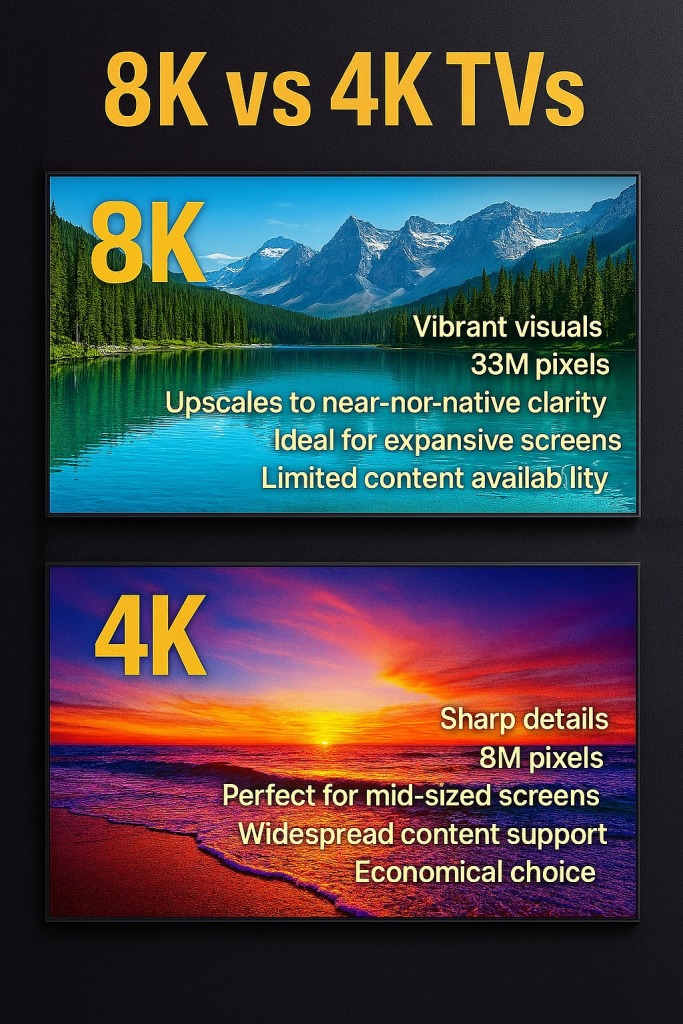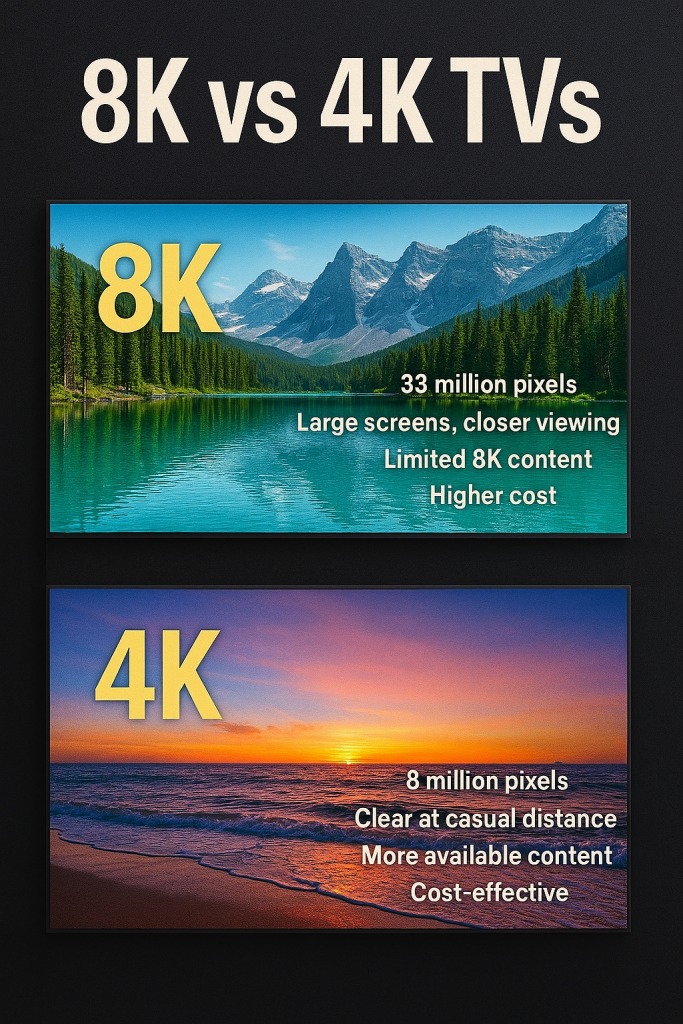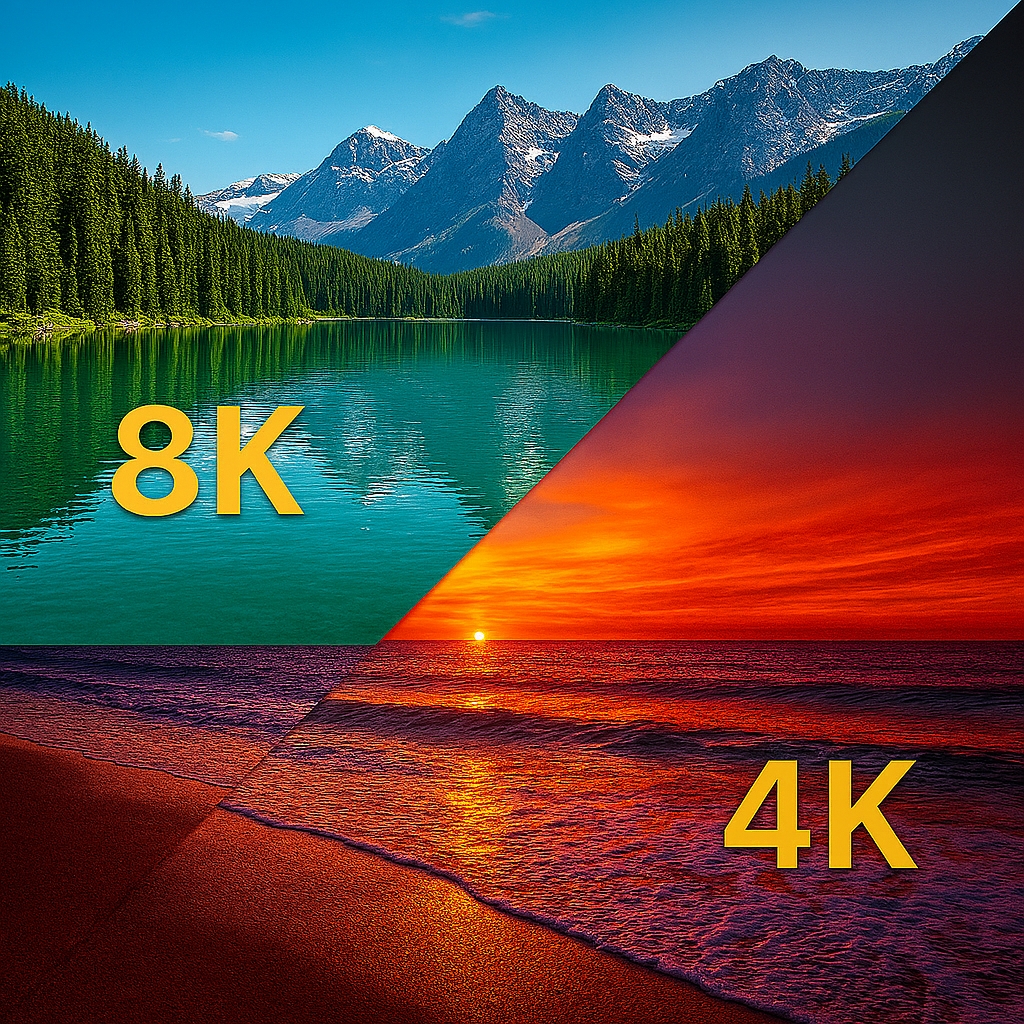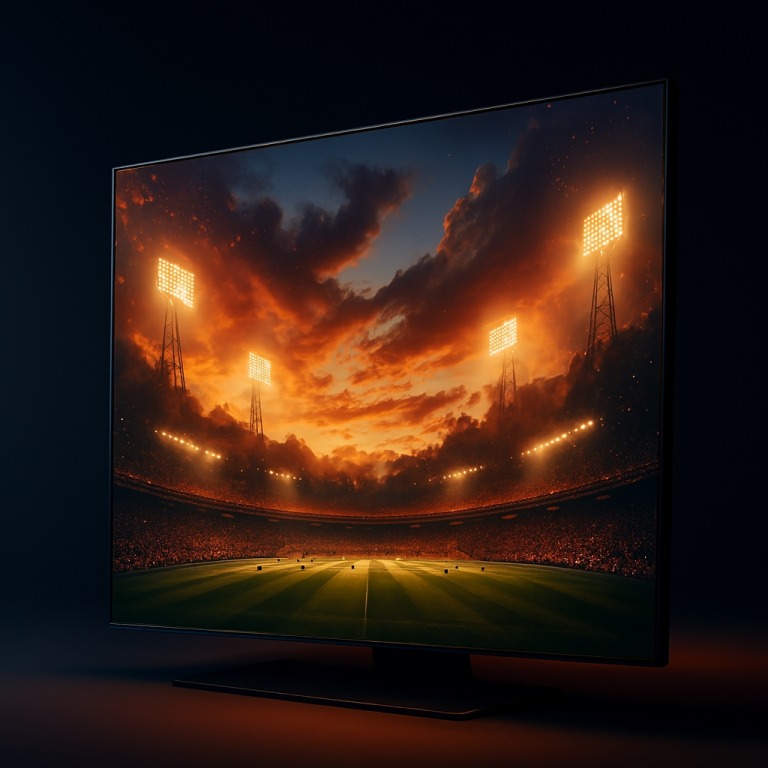8K vs 4K TVs – Powerful Resolution Pixel Divide
8K vs 4K TVs – Powerful Resolution, Performance, and Practical Impact
How The Powerful Resolution Differs Between 8K Performance vs 4K Performance
8K vs 4K TVs – What is the Difference starting at the powerful resolution which defines the number of pixels displayed on a screen. A 4K TV presents 3840 x 2160 pixels, totaling over 8.3 million pixels. An 8K TV quadruples that, offering 7680 x 4320 pixels—over 33 million. This increase in pixel density allows for finer detail and smoother gradients, especially on very large screens. The difference becomes more noticeable when sitting close to the display or viewing ultra-large panels above 75 inches. However, the human eye has limitations in perceiving detail beyond certain thresholds, especially at standard viewing distances. While 8K offers theoretical clarity advantages, the practical impact depends heavily on screen size and proximity. Pixel density also affects text sharpness, edge definition, and image layering. In professional environments like medical imaging or design visualization, 8K can offer tangible benefits. For general home viewing, the perceptual leap from 4K to 8K is often subtle unless paired with optimized content or remastered and viewing conditions.Out of 8K Performance vs 4K Performance which is betetr.
Image Processing and Upscaling
Most 8K content today is upscaled from lower resolutions. Upscaling uses algorithms to interpolate missing pixels and enhance image clarity. Advanced processors in 8K TVs apply machine learning and edge detection to preserve detail and reduce artifacts. 4K TVs also use upscaling for HD content, but the leap from HD to 4K is more perceptible than from 4K to 8K. Upscaling quality varies by brand and chipset, with some models offering near-native sharpness. The effectiveness of upscaling depends on source quality, motion complexity, and color depth. Poorly upscaled content can appear soft or artificially sharpened. High-end 8K TVs often include real-time scene analysis to adjust contrast, noise reduction, and texture enhancement. These features improve perceived resolution but do not replace native 8K footage. Upscaling is a bridge—not a substitute—for true high-resolution media.
Content Availability and Format Support
Native 8K content remains limited. Streaming platforms, broadcasters, and studios have not widely adopted 8K due to bandwidth constraints and production costs. Most available content is still mastered in 4K or HD. Some YouTube creators and demo reels offer 8K footage, but mainstream films and series rarely do. 4K, by contrast, is now standard across Blu-ray, streaming, and gaming platforms. HDMI 2.1 supports 8K transmission, but requires compatible cables and devices. Codec efficiency plays a role—HEVC and AV1 enable compressed 8K delivery, but not all devices support them. Gaming consoles like the PS5 and Xbox Series X prioritize 4K with high frame rates, while 8K gaming remains experimental. For most users, 4K offers a richer content ecosystem and broader compatibility. Until 8K production becomes more accessible, its full potential remains underutilized.

Viewing Distance and Screen Size
The benefits of 8K resolution are most visible on screens larger than 75 inches. At typical living room distances—around 2.5 to 3 meters—the human eye struggles to distinguish individual pixels beyond 4K. To perceive the added detail of 8K, viewers must sit closer or use larger displays. This makes 8K more relevant for home theaters, commercial signage, or immersive installations. For smaller screens or casual viewing, 4K provides sufficient clarity. Pixel density scales with screen size—on a 55-inch TV, the difference between 4K and 8K is nearly imperceptible. Optimal viewing distance for 8K is roughly 1.5 times the screen height, compared to 2–2.5 times for 4K. Ergonomics and room layout also influence how powerful resolution is experienced. Without proper setup, the advantages of 8K may be lost.
Color Depth and HDR Performance
Resolution is only one aspect of image quality. Color depth, contrast ratio, and HDR capabilities play equal roles. Both 4K and 8K TVs support HDR formats like HDR10, Dolby Vision, and HLG. These technologies enhance dynamic range, allowing brighter highlights and deeper shadows. Bit depth—typically 10-bit or higher—enables smoother gradients and richer color transitions. 8K TVs often include advanced backlighting systems, such as mini-LED or OLED panels, which improve contrast and black levels. However, these features are also present in premium 4K models. The visual impact of HDR often exceeds that of resolution alone. Proper calibration and content mastering are essential to fully realize HDR benefits. In many cases, a well-calibrated 4K HDR TV can outperform a poorly tuned 8K display.
Motion Handling and Frame Rate
Higher resolution demands more processing power for motion clarity. 8K TVs must manage four times the pixel data of 4K, which can affect frame rate and response time. Motion interpolation and black frame insertion are used to reduce blur and judder. Both 4K and 8K TVs support high refresh rates—typically 120Hz or higher. Gaming and sports benefit from smoother motion and reduced input lag. HDMI 2.1 enables variable refresh rate (VRR) and auto low latency mode (ALLM), improving responsiveness. Frame rate consistency is crucial for immersive viewing, especially in fast-paced scenes. While 8K TVs handle motion well, their performance depends on processor strength and panel technology. For most users, 4K offers excellent motion clarity without the added processing overhead.
8K vs 4K TVs – Considerations
Storage and Bandwidth Considerations
8K content requires significantly more storage and bandwidth than 4K. A single minute of uncompressed 8K video can exceed several gigabytes. Streaming 8K demands high-speed internet—typically above 50 Mbps for stable playback. Compression algorithms reduce file size, but may introduce artifacts or reduce fidelity. Local playback via USB or media servers requires compatible formats and decoding support. Cloud storage and distribution infrastructure are still adapting to 8K demands. For creators, editing and rendering 8K footage requires powerful hardware and optimized workflows. Consumers must consider data caps, buffering, and device compatibility. Until infrastructure scales, 4K remains more practical for everyday use.
Energy Consumption and Heat Output
Higher resolution panels consume more power due to increased pixel count and processing demands. 8K TVs often require stronger backlighting and more advanced chipsets, leading to higher energy usage. Heat output can also increase, especially during intensive tasks like gaming or streaming high-bitrate content. Manufacturers implement energy-saving modes and dynamic brightness controls to mitigate this. OLED panels offer lower power consumption for dark scenes, while mini-LEDs balance brightness and efficiency. Energy ratings vary by model and usage patterns. For eco-conscious users, 4K TVs generally offer better efficiency without compromising quality. Long-term usage and environmental impact should factor into purchasing decisions.

Cost and Market Positioning
8K TVs are positioned as premium products, often priced significantly higher than 4K counterparts. The cost reflects panel complexity, processing hardware, and limited production scale. Entry-level 8K models may lack advanced features found in high-end 4K TVs. As manufacturing scales and competition increases, prices may drop—but currently, 8K remains a luxury tier. 4K TVs offer a wide range of options across budget levels, with excellent performance even in mid-range models. Value depends on use case—professional environments may justify 8K investment, while casual viewers benefit more from high-quality 4K. Cost-to-benefit ratio favors 4K for most consumers.
Design and Build Quality
8K TVs often feature premium materials, ultra-thin bezels, and minimalist aesthetics. Their design reflects flagship status, with attention to detail and build integrity. Wall-mounting and cable management are optimized for clean installations. 4K TVs also offer sleek designs, especially in mid-to-high tiers. Panel thickness, stand stability, and port placement affect usability. Acoustic design—such as integrated speakers or soundbars—varies by model. While design does not impact resolution, it influences user experience and room integration. Both formats offer stylish options, but 8K models tend to emphasize luxury and innovation.
Software and Smart Features
Smart platforms in 8K TVs include voice control, app ecosystems, and AI-driven recommendations. Operating systems like Tizen, webOS, and Google TV support streaming, gaming, and smart home integration. 4K TVs offer similar features, often with faster updates and broader compatibility. Software optimization affects responsiveness, app stability, and user interface. Firmware updates can improve performance and add new features over time. Smart features enhance convenience but vary by brand and model. Both 4K and 8K TVs support casting, screen mirroring, and multi-device connectivity. The smart experience is more dependent on software than resolution.
Audio Performance and Integration
Built-in audio systems in 8K TVs often include Dolby Atmos support, upward-firing speakers, and spatial processing. These features create immersive soundscapes without external equipment. 4K TVs also support advanced audio formats, though entry-level models may require soundbars for optimal performance. Audio clarity, bass response, and dialogue enhancement vary widely. Acoustic tuning and speaker placement affect soundstage and immersion. For cinematic experiences, external audio systems offer superior fidelity. Resolution does not directly impact audio, but premium 8K models often bundle better sound hardware.
Longevity and Future-Readiness
8K TVs are often marketed as future-ready, anticipating a rise in ultra-high-resolution content and next-gen broadcasting standards. However, the timeline for widespread 8K adoption remains uncertain. Content production pipelines, storage infrastructure, and consumer bandwidth are still optimized for 4K. Studios and networks prioritize HDR, frame rate, and color grading over raw resolution. Meanwhile, 4K continues to evolve with refinements in panel technology, codec efficiency, and smart integration. Firmware updates and modular hardware designs extend the lifespan of high-end 4K models. For most users, investing in a well-supported 4K TV offers greater longevity and compatibility. The future of 8K depends not just on hardware, but on ecosystem alignment across content creation, distribution, and consumer access.
Broadcast Standards and Industry Adoption
Global broadcast standards are slowly evolving to accommodate higher resolutions, but 8K remains experimental in most regions. Japan’s NHK has led limited 8K broadcasts, primarily for demonstration and research. Other countries focus on expanding 4K coverage, with terrestrial and satellite networks upgrading infrastructure. Compression standards like HEVC and AV1 enable more efficient transmission, but require compatible decoders and playback systems. Regulatory bodies and industry consortiums are still evaluating the cost-benefit ratio of 8K deployment. Camera manufacturers, post-production studios, and streaming platforms must align for seamless delivery. Until these systems converge, 4K remains the dominant format for broadcast and streaming. The shift to 8K will be gradual, shaped by economics, consumer demand, and technological feasibility.
Gaming and Interactive Media
Gaming is one of the most demanding use cases for high-resolution displays. While 4K gaming is now mainstream, 8K gaming is limited by hardware constraints. GPUs capable of rendering native 8K at high frame rates are rare and expensive. Most consoles and PCs prioritize 4K with ray tracing, HDR, and high refresh rates. Upscaled 8K gaming exists, but often sacrifices performance for resolution. Input lag, thermal output, and frame pacing become critical at 8K. Game engines must optimize texture resolution, draw distance, and anti-aliasing to maintain fidelity. For immersive experiences, frame rate and responsiveness often outweigh resolution. Virtual reality and augmented reality prioritize latency and pixel density, but rarely operate at native 8K. For most gamers, 4K offers the best balance of visual quality and performance.
The Pixel Divide
Professional and Commercial Applications
Outside consumer entertainment, 8K serves specialized roles in professional and commercial settings. Medical imaging, architectural visualization, and scientific research benefit from ultra-high resolution. In retail and public installations, 8K displays offer stunning clarity for signage and interactive exhibits. Film studios use 8K cameras for future-proofing and post-production flexibility, even if final output is downscaled. Museums and galleries deploy 8K for immersive storytelling and digital restoration. These applications justify the cost and complexity of 8K systems. However, they rely on controlled environments, curated content, and dedicated infrastructure. For general consumers, these benefits are rarely accessible or necessary. The professional edge of 8K lies in precision, scale, and context—not everyday viewing.
Environmental Impact and Sustainability
Manufacturing 8K panels requires more raw materials, energy, and complex logistics than 4K. The increased pixel density demands tighter tolerances and more advanced fabrication techniques. Transporting and packaging larger screens adds to carbon footprint. Energy consumption during use is also higher, especially for peak brightness and processing-intensive tasks. E-waste concerns grow as consumers upgrade prematurely or discard older models. Sustainable design practices—like modular components, recyclable materials, and energy-efficient backlighting—can mitigate impact. Some manufacturers offer take-back programs and eco-certifications. Still, the environmental cost of scaling 8K production must be weighed against its practical benefits. For eco-conscious creators and viewers, high-quality 4K with sustainable sourcing may offer a more responsible path.

Consumer Perception and Psychological Impact
Resolution influences not just technical clarity, but emotional and psychological engagement. Higher pixel density can enhance realism, depth, and immersion—especially in nature documentaries, cinematic storytelling, and abstract visuals. However, perceptual saturation occurs when the brain can no longer distinguish added detail. Overly sharp images may feel clinical or artificial, reducing emotional resonance. Texture, motion, and color harmony often matter more than resolution alone. Viewers respond to narrative coherence, symbolic layering, and aesthetic rhythm. In editorial and symbolic contexts, resolution supports—but does not define—meaning. 4K performance offers a mature balance of fidelity and warmth, while 8K performance risks becoming a technical showcase without emotional grounding. The psychological impact of resolution depends on how it’s used—not just how many pixels it contains.
Conclusion – 8K Performance vs 4K Performance
The difference between 8K and 4K TVs is both technical and contextual. While 8K offers superior pixel density and potential for ultra-detailed imagery, its benefits are conditional—dependent on screen size, viewing distance, content availability, and processing power. 4K remains the most practical and widely supported format, balancing clarity, compatibility, and cost. For creators, editors, and viewers alike, resolution is one layer in a larger symbolic and experiential system. Choosing between 8K and 4K requires understanding not just what each can do, but how they fit into your workflow, values, and environment. As technology evolves, the conversation will shift from resolution to integration—how screens support storytelling, healing, and inclusive design across cultures and contexts.
Join the Discussion
Have you experienced both 4K performance and 8K performance in your creative or viewing practice? What symbolic or emotional differences did you notice? Are you designing for resolution—or for resonance? What is your pixel divide?
#SymbolicResolution #EditorialClarity #8Kvs4K #VisualTaxonomy #PixelDepth #CreativeFidelity #ScreenEcology #InclusiveDesign #TechWithoutHype #VisualHealing #ModularEditorial #FutureReadyDisplays #ResolutionInContext #BeyondPixels #EthicalViewing







